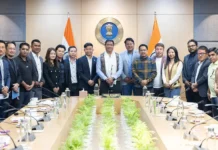ITANAGAR, 20 Aug: Chief Minister Pema Khandu said that “it is only because of the NDA government at the Centre and the BJP governments in the two neighbouring states (in other words, the double-engine government), and because of the concerted efforts of all stakeholders that Assam and Arunachal Pradesh have come a long way in fostering harmony and peaceful coexistence among the people living on the interstate boundary.”
Attending an interactive session on ‘Understanding socio-cultural issues of Bodos in Arunachal’ at the DK Convention Centre here on Sunday, Khandu said that both the states are moving forward with conviction, openness and compassion for greater cultural cooperation between the people of the two states.
He said that the disputes along the Assam-Arunachal interstate boundary, of which most areas are inhabited by the Bodos, have “almost been resolved, barring a few pockets.”
Khandu, however, remarked that “drawing a boundary line is not the end of the job. For peace and progress to go along together, people living on either side of the boundary have to work together with bonhomie and brotherhood.”
“This wasn’t possible earlier because of the lack of sincerity of the Congress government and the convoluted approach with which they used to work. They had neither clarity of thought nor any concrete action plan. But the BJP government was determined to make headway with the resolve of abhi nahi toh kabhi nahi,” he said.
Criticising the Congress for its “step-motherly treatment of and irresponsible attitude towards the Northeast,” the CM said that “this attitude caused damage to the Northeast, particularly Assam, which had to go through a tumultuous phase of violence, gun culture and insurgency.
“Things have changed drastically since 2014. Peace has come back and development is taking place rapidly,” he said.
Terming corruption one of the biggest hurdles to development and peace in the region, Khandu blamed it too on the Congress regime, saying that “corruption was a gift from the then central government.”
“Today, our government, backed by our political will – we are rooting out corruption from every sphere of governance,” he said.
Paying rich tributes to Bodofa Upendranath Brahma – considered the Father of the Bodos – whose pioneering non-violent struggle paved the way for self-determination and autonomy, leading to the creation of Bodoland, Khandu said that “the Bodos and Arunachalees share a special rapport based on faith and respect since time immemorial.”
“The age-old relationship shared by Arunachalees and Bodos has made today’s event possible,” he said, and hailed Bodoland Territorial Region (BTR) Chief Executive Member Pramod Boro for his presence along with other BTR executive members.
“After the NDA government assumed charge in Bodoland in December 2020 under the leadership of Pramod Boro, a new era of peace and development started in the region. I am also very happy to note that the BTR Peace Accord-2020, which was signed in the presence of union Home Minister Amit Shah, has paved the way for permanent peace in Bodoland,” he said.
“This,” Khandu observed, “is a very positive development, not only for Bodoland but also for the entire northeastern region.”
“Being the gateway to the Northeast, I believe that, in the days ahead, Bodoland will emerge as the most peaceful and progressive frontier of the region,” he added.
Responding to a proposal from the BTR chief, the CM assured to establish a cultural stall, showcasing Arunachal’s tourism potential, in a complex to be constructed by the BTR government in Srirampur, the entry point into Assam from West Bengal.
He assured also to construct a cultural centre for the Bodo community in Itanagar.
“For the Bodo brothers and sisters staying in Arunachal Pradesh, I pledge my full cooperation and support to them in the future,” Khandu added.
The event was attended by top leaders of the BTR, Itanagar legislator Techi Kaso, and members of the Bodo Sahitya Sabha, the Nyishi Elite Society, the All Bodo Students’ Union, and the Arunachal Pradesh Bodo Welfare Society. [CM’s PR Cell]







